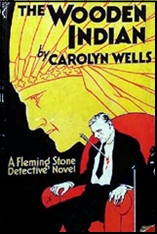Sat 7 May 2022
Archived Mystery Review: CAROLYN WELLS – The Wooden Indian.
Posted by Steve under Reviews[2] Comments
CAROLYN WELLS – The Wooden Indian. Fleming Stone #41. J. B. Lippincott, hardcover, US, 1935.
While obviously a mystery novel, maybe even a work of detective fiction, The Wooden Indian is very nearly a fantasy, simply because its resemblance to reality is so razor slim.

At least, I *think* it’s slim. It takes place in the Connecticut of the 1930s (New London County), and the country club set is very much a part of it. It’s not a world which I was ever a part of, then or now, and maybe it’s my fault. Maybe I just don’t recognize how close to reality it really is (or was).
At any rate, David and Camilla Corbin are valued members of the Pequot Club, but they are not very happily married. He is wealthy, a stamp collector, and an amateur historian specializing in local Indian legends. She is serenely beautiful, subject to scathing comments from her husband, and every other unattached male in the neighborhood is attracted to her like moths to a flame.
Wait. There’s more. Legend has it that a curse is upon the Corbin family, and every 100 years one of them will die at the hands of the spirit of a vengeful Indian chief, with bow and arrow. This is the year — and this the stuff of which detective stories are made. It’s no wonder that a friend of Fleming Stone, noted criminologist, calls him in, even before the first murder occurs. As stated on pp.26-27: “Bob’s wire didn’t promise a case exactly, but it held out interesting hopes …”
In other words, what we are playing here is a game. The rules are fixed. The victim has no say in the matter, even though his identity is known 80 pages in advance. [WARNING: Major Plot Alerts in the Paragraphs ahead.] There is a ghost at hand, there is even what is described on p.191 as a “locked room”, even though the murder took place 80 pages before that and this is the first (and last) time it’s mentioned.
The solution, by the way, describes (in some detail) the trick the killer used to get in, and yet the only thing blocking the doorway was the red cord used by the dead man to signal that he was listening to the radio and did not want to be disturbed. When Stone came upon the scene earlier, he “lifted one end of the red cord from its hook and went in,” (p.109)
While the book is listed in Bob Adey’s book on Locked Room mysteries, I must have missed something.
The killer is not the secretary, as Fleming Stone first surmises. (Apparently the last mystery Stone has read was The Leavenworth Case, and evidently, in that one the secretary *was* the killer.) Instead it’s a trivial variation on the “person most likely” — in other words, a person so obvious that I thought that that was the gimmick. Sorry. No such luck.
NOTE: Obviously forgetting I first read this book back in 1991, as above, I read and reviewed it again on this blog here in 2009. These comments followed Bill Pronzini’s take on it here, a 1001 Midnights review.
May 7th, 2022 at 11:43 pm
Wells great contribution is writing about the genre, not in it.
I know she has her defenders here and elsewhere, but you can’t get more colorless or boring than Fleming Stone or Penny Wise or Alan Ford or any of her other detectives or characters and plots with paper cut outs just aren’t my thing.
Those Dennis Wheatley mystery folios with physical clues had better characterizations.
I enjoy the game aspect of the mystery novel and don’t need all that much grounding in reality, but I do need wit, mystery, suspense, cleverness, interesting characters, and all those little things that Wells chooses to ignore or is incapable of delivering.
Her career spanned forty years, and she was in print for most of it, but her books are like lumpy gray oatmeal served by your Mom: you may appreciate the effort, but it’s still tasteless and hard to digest.
Historically she is important, but as entertainment goes her hits are few and hard between, and this from someone who liked a few Lee Thayer Peter Clancy books.
May 8th, 2022 at 8:08 am
It is surprising how many books she wrote — 170, according to Wikipedia, not all of them mysteries but with over 60 in her Fleming Stone series alone — to so little avail. We discussed her thoroughly at the time of my previous review of this book, and again before that after Bill Pronzini’s review, and I don’t recall very many of the comments were favorable. I also don’t believe there’s going to be any surge of interest is her work, other than historically, as you say.